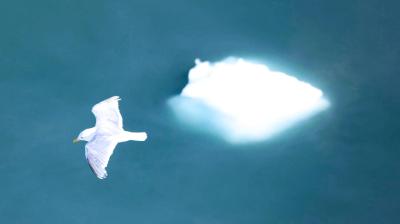One Planet-Polar summit calls for action on the cryosphere

The One Planet – Polar Summit hosted by French President Emmanuel Macron called for urgent action to cut greenhouse gas emissions, for more in-depth scientific research on the cryosphere and better integration of the effects of the retreat of the cryosphere into policy-making.
A summit declaration pledged support for a United Nations Decade on Polar and Glacier Sciences. This would commence in 2025 – which is the International Year of Glaciers’ Preservation - and feed into the Fifth International Polar Year in 2032-33. It would involve WMO and the UN Educational, Scientific and Cultural Organization and partner organizations like the International Science Council and Antarctic Treaty System organizations.
“Climate change is already here and it’s a threat which is there and is getting worse by the minute. It is threatening millions already and soon billions of inhabitants,” said President Macron.
The high-level One Planet-Polar segment on 10 November followed two days of meetings which forged new momentum between high altitude and high-latitude science. Scientists, decision-makers and local communities from more than 40 nations attended the event in Paris.
“One of the most visible impacts of climate change is seen in the cryosphere, with the acceleration of melting of glaciers and sea ice,” said WMO Secretary-General Prof. Petteri Taalas. “Unfortunately the high concentration of greenhouse gases in the atmosphere means that melting of glaciers and sea level rise is expected to continue for the coming millennia,” he said.
Canary in the coalmine
A new scientific report was released at the summit, highlighting the acceleration of climate change impacts on the cryosphere. It called for better coordination, more research and data exchange, improved forecasts and monitoring, increased involvement with local and indigenous communities and expanded education and outreach.
“The cryosphere, the white landscapes is the canary in the coalmine of climate and biodiversity crises due to human pressures including greenhouse gas emissions,” said Antje Boetius, Co-chair of the Scientific Advisory Board of the conference, and Director of the Alfred Wegener Institute, Helmholtz Centre for Polar and Marine Research.
Jérôme Chappellaz, the other Co-chair and Chairman of the Ice Memory Foundation highlighted some of the impacts:
- One additional cm of sea level rise means that 2 to 3 million additional people will be threatened by annual floods.
- Every ton of additional carbon dioxide in the atmosphere removes 2 to 3 square meters of sea ice in the Arctic
- Two billion people rely on water resources coming from mountain glaciers.
- On the way to 1.5 °C gigatonnes of carbon released from the permafrost - up to 5 years of global carbon dioxide emissions by human beings. Wildfires in the Arctic bring an additional threat.
“Science is the best partner. Science has always provided solutions and innovations, but without stronger government intervention it will be too slow,” he said.

Tipping points
The cryosphere refers to regions of Earth’s surface where water is in solid form: including the vast ice sheets in Antarctica and Greenland, sea ice in the Arctic and Antarctic, snow cover, mountain glaciers and permafrost.
These regions, which cover 10% of the Earth’s surface and are home to unique ecosystems, are bearing extreme consequences of the climate crisis. They are also contributing to it through sea level rise.
The summit raised the alarm about the scale and the speed of the melting ice and thawing permafrost and the risk of crossing thresholds and tipping points, which have increased with the continued rise in global greenhouse emissions. There is special concern about the ticking timebomb of melting permafrost and its potential to release vast quantities of methane, which is a powerful greenhouse gas.
It noted the “almost irreversible retreat of some 200,000 glaciers, located in Europe, Africa, Oceania, Asia and the Americas.”
The years 2021 and 2022 saw a massive loss in mountain glaciers, which on average was 20% higher than the previous decade. It is already expected that at least half of these glaciers will be lost by 2100.
Surface temperatures have increased in the Arctic by up to four times the global average in the past forty years and a huge loss of ice sheets in Greenland and Antarctica. This loss has increased four-fold in 30 years, thus contributing to average sea levels rising at a faster rate.
October Antarctic sea ice extent was the lowest on record for the time of year for the sixth consecutive month, and has been accompanied by dramatic ecological changes, including catastrophic losses in Emperor Penguin populations.
Summit participants also warned about the impact of the retreat of high mountain glaciers. The food and drinking water security of two billion people depend on high elevation glaciers, and they will suffer from disastrous effects on the flow of rivers, agriculture and electricity production.
One person in ten lives in a coastal area and will be exposed to the effects of rising sea levels, which is half due to the melting of the cryosphere, at a rate which has been increasing since the 1990s.
“We human beings do have the ability to act in equitable ways to make a difference and avoid the worst impacts of climate change,” said Jim Skea, Chair of the Intergovernmental Panel on Climate Change.
- WMO Member:
- France










